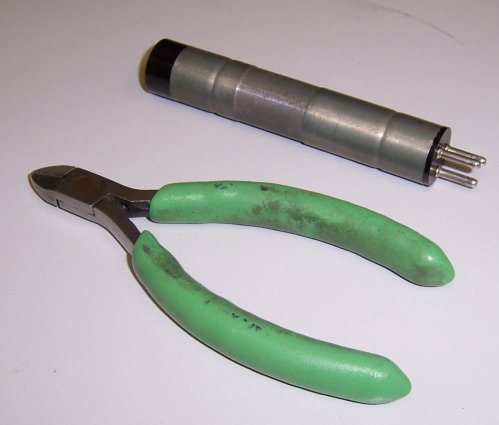
It still hurts like hell to lean back against anything (for latecomers, I’m working through a nasty case of shingles) so I spent a good part of today sitting on my venerable and much taped-up barstool downstairs in my shop, drowning my pain in milk-jugs full of antique electronic parts. As I mentioned yesterday, having tried and failed to do so in 1963, I’m attempting to build a Geiger counter. I’m going to try to do it without active elements; that is, without including an audio amplifier for pulses coming off the Geiger tube. That makes speaker output impossible, but I have 2500-ohm “can” headphones from WWII, which are about as sensitive as that sort of transducer ever gets.

The first Geiger tube came with the morning’s mail. It’s a Victoreen OCD-D-103, a NOS spare for the famous yellow Victoreen civil defense portable counters from the 1950s. I actually found a mating 3-pin female connector in my junkbox, which is good, since I have no idea where I’d look otherwise. (The alternative is cannibalizing an octal tube socket for individual pin-grippers, generally by crushing a Bakelite socket in a vice until it crumbles.) Including the pins, the tube is just under 4″ long and 0.625″ in diameter. I’ll have to build a probe housing for it eventually, but near-term I’ll mount it in a pill bottle, of which there are legion.
The top photo is a stack of three 1000-volt mica capacitors, adding up to .048 MFD. That’s about what one circuit calls out, but more is better, and I have a 1950s steatite banana plug bar into which two such stacks will go. So I’ll build a second and put them in parallel. That will get me to about 0.8 MFD, which ought to be enough. If it isn’t, I’ll see what else I can scrounge in the line of high-voltage caps.
I’m modifying an old ceramic wafer switch to be a current interrupter, but I need to get a little farther along before I know if that will work. Those familiar with such switches will understand: I bent down the limit tabs so that the switch shaft can be turned continuously, and at each click current will make-and-break between the wiper and the stationary contacts. Crank it like a Model T, and you generate a series of quick DC pulses to the transformer.
Or that’s the theory, anyway. We’ll see how well it works. More as it happens.










